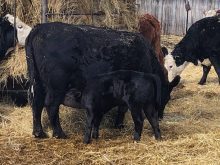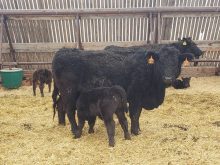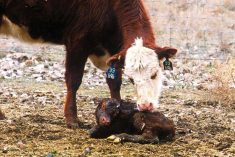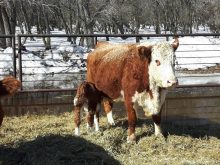Modern tool boxes in cow-calf production would not be complete without preferably at least two esophageal feeding tubes. These relatively simple, multipurpose feeding tools allow a safe, convenient method to give things such as colostrum or colostrum replacers, electrolytes, milk replacers and a few other treatments to calves.
No producer should feel they don’t know how to use one, or that it is an unsafe method of giving liquids. If there is any doubt, get someone to show you. Better yet, the Beef Cattle Research Council (BCRC) just released a short teaching video on how to drench a calf properly on its video page. It’s called Calf 911 “The In and Outs of Esophageal feeding”. It is well worth the view, as is signing up for their free blog on many other benefits to cattle production. There are good pictorials on it and when using a few fail-safe checks it is virtually impossible to get product down the wrong spot.
Read Also

Harvest wraps up and fall work begins
At the Eppich famly ranch in western Saskatchewan, the fall harvest was successful with few breakdowns, cows and calves have been sorted and a new tractor has arrived
I will not go over ways to safely insert the feeder so have a look at the video which comes up immediately when you search the BCRC website. It was released in mid-January 2022, in great time for this year’s calf crop.
Esophageal feeders can be purchased at most feed, farm-supply stores or vet clinics. They are well worth the roughly $30 investment. I recommend having one for healthy newborns and one for sick calves. They can easily be cleaned and then disinfected with Virkon disinfectant.
I recommend they always be used to bump up the fluid consumption in diarrheic calves showing signs of dehydration. I almost always recommend the HE (high energy) electrolytes in these situations. Your veterinarian will recommend the amount and frequency, depending on the size of calf and degree of dehydration. It is important to always see if the calf will suckle first on its own, but if the suckle reflex is weak or slow, then use the feeder.
Don’t hesitate to act
With newborns, there should be little hesitation. If there has been any doubt whether the calf has sucked or will suck shortly after birth, then colostrum should be given with the feeder. Ideally, colostrum should be consumed within a couple of hours after the calf is delivered. This could be colostrum that has been milked from the calf’s mother, or if that’s not an option, use a commercially available air-dried product such as HeadStart from the Saskatoon Colostrum Company.
There are several situations where a producer should be prepared to feed colostrum to a newborn calf — for example, in the event of a hard pull (difficult delivery), or if for some reason, newborn calves lack vigour or the calf appears weak with difficulty to stand. Or often in the case of twins the calves may be weak, or a cow just has limited milk production. In these cases, we need to supplement their calves to eliminate the worry about the failure of passive transfer. The reduced absorption of maternal immunoglobulins found in colostrum is described as failure of passive transfer (FPT)
In the case of orphan calves or those we find hypothermic or starved due to a mother with no milk, the best remedy is to tube-feed a warm, good-quality milk replacer given quickly with an esophageal feeder. One feeding may be all you need but if others are required there are also really good nipple bottles that can be used.
As in the recent long, drawn-out cold snap in early January, when treating calves it is important to take their temperature because if it’s below normal, feeding with a warm milk replacer will help bring up the core body temperature. Remember the milk replacer, colostrums or electrolytes are great if they are warm, but just like feeding a human infant, they can’t be too warm. Test the temp on your own skin first.
Feeding electrolytes for scours or other conditions where calves are dehydrated can save their lives… of that there is no doubt.
Calves need about 10 per cent bodyweight per day of milk or milk replacer just for maintenance. This works out to about one litre, four times daily. If calves will suck vigorously that is great. Otherwise, tubing gets the needed hydration into them quickly and with the right balanced electrolytes and energy they need.
Other uses
Esophageal feeders can be used for giving any oral product to calves up to about two months of age. Products for bloat, as any oral antibiotics, can be administered with the same feeder. Keep them clean, and it is best to use one feeder for newborn calves that may require colostrum or milk replacer and a second feeder to use on sick calves. To keep cross-contamination to a minimum, once the feeder is cleaned and left to dry, it can even get a further rinse once in a while with something like Virkon disinfectant.
Always pay attention, as it is possible for the stiff applicator tube to separate from the flexible tubing and be swallowed. A few calves have needed surgery to remove swallowed tubes. They get stuck in a very tight rumen. Also, replace feeders if the tube becomes rough and abrasive, or even just on a regular basis as they take lots of abuse from calves sharp teeth.
Most producers involved with a heavy calving operation would admit they use an esophageal feeder almost daily and sometimes several times a day. All products applied give the calf some realistic chance of achieving or maintaining good health.
Have a great spring everyone, and don’t forget to give the BCRC tubing video a look-see. You may be pleasantly surprised as to how many calves you can turn around with just an esophageal feeder and the product that is given. Collectively they may save calves or prevent sick calves from requiring more aggressive treatments.















